The Last Great Place
Blue skies and endless open space, are only part of the attraction to Mongolia, a place so far off the map that there are hardly any roads, or flights. Not much food, either, except mutton - mounds and mounds of mutton. Still, to those interested in a decidedly different way of life and a land with no fences, this may well be the world's last great place.
By Ron Gluckman /Ulaan Baatar, Khinte, and the Gobi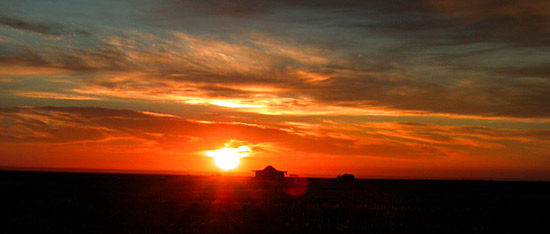
FROM SLABS OF BLACK ROCK deep inside Yolyn Am (Vulture’s Mouth) Gorge protrudes an icy tongue, sparkling blue-white, glistening like diamonds, sprayed with dew, under a cloudless Mongolian sky.
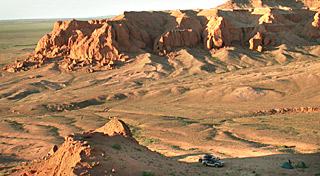 Among so
many wonders in a remote stretch of Mongolia, near the Flaming Cliffs, famed for
mankind’s greatest dinosaur discoveries, the opalescent glacier is merely one
more lip-smacking sight in a country full of head-banging marvels.
Among so
many wonders in a remote stretch of Mongolia, near the Flaming Cliffs, famed for
mankind’s greatest dinosaur discoveries, the opalescent glacier is merely one
more lip-smacking sight in a country full of head-banging marvels.
To get to this place, we have driven for days over some of the starkest terrain on earth, crossing vast stretches of emptiness on nearly invisible tracks scratched into a rolling carpet of dirt, scrub, and moss.
But if the Gobi’s mesmerizing topography borders on the monotonous, that’s just part of its allure. Just when the endless flatness lulls you into a trance—insofar as this is possible while bumping along in a dilapidated Russian jeep—the desert offers up unexpected marvels: deep canyons, or windswept sand dunes, or dazzling rock formations.
Or, this icy tongue wiggling through Yolyn Am — an odd juncture where the northern hemisphere's southernmost glacier meets its northernmost desert, and the only place on Earth where desert sand is licked by glacier.
Minutes before, in shorts and sandals, I was hiking through fields of wildflowers. Now, the sunscreen is frozen on my skin. Such are the dramatic contrasts that define the Last Great Place.
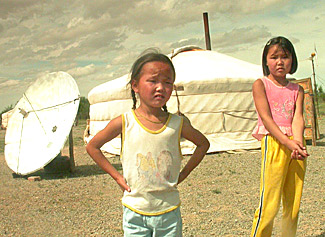 At least, that’s the way recent stories have portrayed Mongolia: as a vast,
undiscovered country; the final frontier. Many travel writers call it their
favorite destination, although Mongolia remains mostly off the map and out of
the news.
At least, that’s the way recent stories have portrayed Mongolia: as a vast,
undiscovered country; the final frontier. Many travel writers call it their
favorite destination, although Mongolia remains mostly off the map and out of
the news.
Except when some natural disaster, like devastating snow storms, sadly several winters in a row now, flings Mongolia onto the front pages, and then just as abruptly back into obscurity.
But not this year—Visit Mongolia Year.
Mongolia’s first-ever tourism campaign began in May 2003, unofficially the start of the country’s short summer season, since that's when temperatures usually top 0. Officials were confident of success, and boasted on their new web site (www.visit2003.mn) of such extravagant measures as the leasing of one Boeing 737. (Mongolia has few flights except from neighboring China and Russia, and not many tourists, either—fewer than 25,000 arrived in 2001, and that was a record.)
And then there were the "Top Ten Reasons to Visit Mongolia," listed right there on the Visit Mongolia homepage. Okay, they only managed to come up with nine, most of them misspelled. Still, what other country can hype as a tourist attraction "No fences," and mean it?
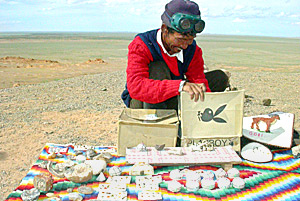 And so in July I find myself on a northbound train from Beijing, eager to see
how things have changed in a land that I explored extensively in the early
1990s, and have yearned to return to ever since.
And so in July I find myself on a northbound train from Beijing, eager to see
how things have changed in a land that I explored extensively in the early
1990s, and have yearned to return to ever since.
Would there be welcoming banners at the border? Ranks of souvenir shops? Meat other than mutton in the restaurants? Would trips into the countryside be the same circumscribed jeep tours to remote gers— wood-framed felt tents — for a taste of well-practiced nomadic hospitality and rock-hard nuggets of yak cheese?
Or, would I be free to roam? In short, was the Last Great Place ready for prime time?
Ulaanbaatar certainly seems in peak form when I arrive in the exhilarating days before the Naadam festival, held every year in mid-July. Though I had heard reports about the capital’s burgeoning restaurant and club scene (described by some enthusiasts as a "Prague-like renaissance"), I am deliciously surprised by the ease, comfort, and diversity of choices.
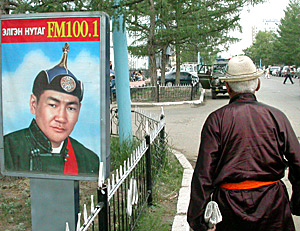 The early post-Soviet
years were marked by line-ups for bread, petrol, and even matches; a dozen years
ago, you had to fight your way—literally—into the city’s few bleak mutton
stalls. Nowadays, options include French bistros, Cuban bars, and German
brewpubs.
The early post-Soviet
years were marked by line-ups for bread, petrol, and even matches; a dozen years
ago, you had to fight your way—literally—into the city’s few bleak mutton
stalls. Nowadays, options include French bistros, Cuban bars, and German
brewpubs.
And Indian restaurants. One night I dine at the Taj Mahal with Martin Joseph, whose brother owns the two-year-old establishment. We’re seated on the rooftop terrace, looking down at the city's delightfully forlorn and utterly out of place concrete blockhouse Soviet-style architecture.
Martin has spent a year in Ulaanbaatar, which everyone here calls "UB." Like every expatriate I encounter, he’s upbeat about the city’s prospects, smiling even as the discussion turns to the weather. I must mention that Martin hails from Kerala in southwest India, where daytime temperatures average 30 degrees Celsius.
UB, the coldest capital on the planet, hits that high perhaps once every few years, and spends most of its long winter at well below freezing. "The way I look at it, there is no bad weather," Martin says, beaming, as he spoons a dollop of chutney onto my plate. "Only bad clothes."
Yet there’s no sign of bad weather or bad clothes in UB during Naadam. Instead, the city and its residents are decked out in traditional finery for the 800-year-old pageant, which has survived more or less unchanged since the days of Genghis Khan.
Back then, the Mongols claimed the largest empire yet forged, one that stretched from the Sea of Japan to the borders of Europe. Naadam commemorates the skills that won it: wrestling, horseback riding, and archery—the eriin gurvan naadam, or "three manly sports."
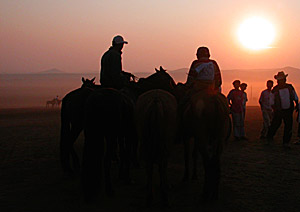 Naadam is celebrated across Mongolia, but festivities are at their boisterous
best in UB. Families from the surrounding countryside pack their gers into
wagons, hitch up the family camel, horse, or yak, and trundle into the capital
to enjoy the games.
Naadam is celebrated across Mongolia, but festivities are at their boisterous
best in UB. Families from the surrounding countryside pack their gers into
wagons, hitch up the family camel, horse, or yak, and trundle into the capital
to enjoy the games.
Men in Mongol warrior–style gear atop ribbon-adorned horses parade across Sukhbaatar Square, UB’s own Red Square. And pictures of Genghis Khan, once banished from school texts by the Communists, are everywhere, on billboards, magazines, bottles of Genghis vodka.
The festival has gone upscale during Visit Mongolia Year. Sky divers swirl over the grandstands of UB’s National Stadium before the start of the wrestling finals, during which no fewer than 512 men, bulky torsos bulging over skimpy leather briefs, square off for a day of single-elimination events.
 Strategy is key to Mongolian wrestling, explains Yura Enktuvshin, a fan, after
watching a match drag on for an hour. But to the uninitiated observer, it simply
seems to take forever. "Clearly, American football isn’t the slowest
sport on earth," mutters a British spectator seated next to me.
Strategy is key to Mongolian wrestling, explains Yura Enktuvshin, a fan, after
watching a match drag on for an hour. But to the uninitiated observer, it simply
seems to take forever. "Clearly, American football isn’t the slowest
sport on earth," mutters a British spectator seated next to me.
At the end of Naadam a fireworks display is followed by a big rock concert. This is a radical departure from a dozen years ago, when the first post-Soviet festival sputtered out leaving thousands of country folk stranded.
The newly elected government, going all out for Naadam, had drained the city’s fuel stocks so that afterwards, when the pumps went dry, trains, planes, and buses were stalled. Anyone without a horse or camel—including tourists—was stuck in the capital for weeks.
These days, however, there seems to be as much action outside the National Stadium as within. On the festival’s final night, I’m drinking Asia’s best beer in the Khanbrau, a German brewpub that is regularly packed.
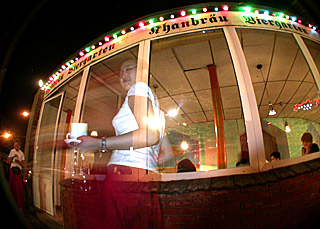 Mongolian
rockers play covers of Coldplay, while women strut past in outfits that would
have seemed risqué even in the wild East European revels following the collapse
of the Berlin Wall.
Mongolian
rockers play covers of Coldplay, while women strut past in outfits that would
have seemed risqué even in the wild East European revels following the collapse
of the Berlin Wall.
Mongolia’s own democratic revolution took place in 1990, bringing a relatively peaceful end to seven decades of Soviet domination. It also sent the economy into a tailspin. But if Naadam took on renewed significance as a break from bleak tidings during the glum years that followed, tonight it is not exactly a topic of bar chatter.
"Nobody in this generation is interested in Naadam," explains Chinzorig, a 26-year-old tour guide. "We’d rather listen to hip-hop," interjects Jargal, a woman a few years younger. "Naadam is old-fashioned."
Contrast this with Asia’s other former Communist countries, where state events still dominate the social agenda. Not in UB, where the younger generation sees no need for prestige-building follies. Instead of reliving past glory, many now go abroad. They return with new ideas, about fashion, making money, and the future.
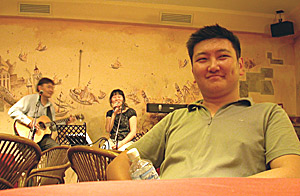 Take Bata, 27. While still
in university in the mid-1990s, he sold second-hand cars from Japan. "It
was good money, and perfect for a student," he says, "since the market
was on weekends. I could make US$15,000 on a Saturday."
Take Bata, 27. While still
in university in the mid-1990s, he sold second-hand cars from Japan. "It
was good money, and perfect for a student," he says, "since the market
was on weekends. I could make US$15,000 on a Saturday."
This past June he opened Silk Road, one of UB’s new wave of restaurants. Diners sit on expansive terraces — refreshing to a city that spent seven decades submerged in dingy Russian vogue — and enjoy stunning views over Choijing Lama Monastery, one of the few religious structures to survive Mongolia’s terrible socialist purges.
Taking shape next door is Bata’s next project: Mongolia’s first boutique inn. "I realized, it’s not how much money you make, but how you make it. I want to create a place where people can experience good service and go away happy," he says. "Mongolia has never had that."
Nor has Mongolia had entrepreneurs like Bata. I meet lots of them: club and pub owners, hoteliers, tour operators, even a bank director — all in their twenties. They wear Western clothes, talk freely, and aren’t afraid to entertain outlandish ideas. The atmosphere is infectious.
Expats — loads of them in a nation where one-third of the economy
is oiled by aid
money — recount real hardships, but still uniformly speak with affection of postings
in this Last Great Place.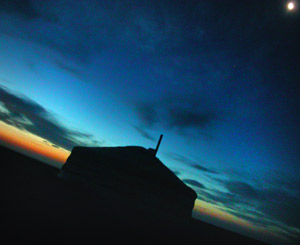
"Mongolia is like one step out of the Stone Age in many ways, but it’s seductive, this fledgling, fresh-out-of-the-bottle economy," says John Savageau, an American who heads MagicNet, with 45,000 customers the country’s largest Internet provider. "It’s a free place now, and people have dreams."
Also bitten by the Mongolia bug is Darius Teter, a deputy director with the Asian Development Bank. "The only thing predictable about Mongolia is its randomness," he says. A nature buff who leaves the office on Fridays with a jeep full of supplies and no real destination, he details frozen engine blocks and scores of life-threatening misadventures. Still, he maintains, Mongolia is "paradise. Really, it is. Just a different sort."
That’s what draws most visitors to this remote land mass, as big as Europe but with fewer than three million people. And eight times that number of sheep and goats. All set in a spectacular canvas of cascading hills and endless plains, trimmed with forest and desert, everywhere looking undeveloped and pure, seemingly unchanged and untouched for eons.
Except in UB. Nobody comes for the urban experience, although this is a small, beguiling capital with good museums and an alluring post-Soviet charm. UB is also a great walking city, albeit one of the few on Earth where you still need to watch out for horse poo. And friendly, too. After a few days, I’m waving to pals like a long-time resident.
Still, Mongolia’s main draw is its outback, meaning anywhere outside UB. A few days after Naadam’s last horse race, I head northeast to the forested hills of Khentii, near the Russian border, in the company of another dreamer, Mark Hintzke.
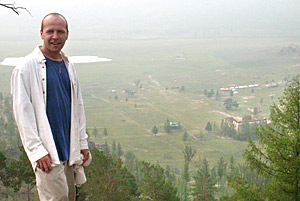 For most of the year, Hintzke is a building contractor in San Francisco.
Summers, he’s back in Mongolia, overseeing an unusual tourism program.
For most of the year, Hintzke is a building contractor in San Francisco.
Summers, he’s back in Mongolia, overseeing an unusual tourism program.
Visitors pay about US$1,000 per week to stay in basic gers overlooking a lake. Horse rides, a standard feature on ger holidays, aren’t on this program. Instead, guests help to restore Baldan Baraivan, one of Mongolia’s largest and most important monasteries.
At least it was, centuries ago. Now, it’s mostly grass and a few sad mounds of rubble, all that remained after the anti-Buddhist purges of the 1930s, which saw thousands of monks slaughtered, exiled, or sent to labor camps.
Around the country, Buddhism is experiencing its own rapid renaissance. Over 95 percent of Mongolians call themselves Buddhist. This is remarkable, considering that under the Communists that number was closer to zero — at least officially.
Everywhere you go nowadays, new temples are sprouting while villages reclaim old ones. Even so, Baldan Baraivan, 300 kilometers east of UB, is exceptional. "This was like a university. It was one of the largest teaching institutions in Mongolia," says Hintzke, poking among rocks for shards of once-magnificent inscriptions. "The valley had 20 temples. It was a huge community."
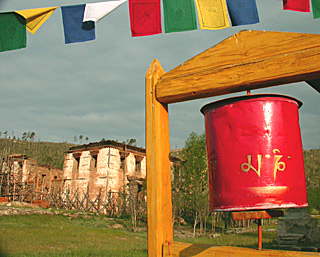 Now, tourists come here to chip away at stucco and hammer floorboards on work
holidays organized by his non-profit Cultural Restoration Tourism Project.
Simply raising money for the restoration wasn’t Hintzke’s style. "I
think bringing people here, letting them see the place and interact with the
locals, is a very important aspect of the project."
Now, tourists come here to chip away at stucco and hammer floorboards on work
holidays organized by his non-profit Cultural Restoration Tourism Project.
Simply raising money for the restoration wasn’t Hintzke’s style. "I
think bringing people here, letting them see the place and interact with the
locals, is a very important aspect of the project."
Not that it has been easy. "Things are going much slower than expected," he concedes. "I suppose I was naïve. I thought, who wouldn’t want to go to a beautiful place and rebuild a temple? I didn’t realize that I’d actually have to convince people."
Volunteers include a California lawyer (who, after logging massive overtime in a credit card lawsuit, "wanted to do something meaningful") and several other Americans who had never even bothered to get a passport. Hardly seasoned travelers.
None minds the spare conditions—but they do complain about the meals. Aside from some greens from the garden, all supplies are transported, along with visitors, on weekly jeep runs from UB, a tortuous 10-hour drive that staff have dubbed "The Blender."
The ride does nothing to improve digestion, or one's appetite in a land renowned for its lack of cuisine. Mongolian diet centers - fixates might be more exact - on meat, mainly mutton, supplemented with bits of bread and noodle and loads of dairy: concrete cheese balls; a kind of yogurt; and alcohol or tea made from the milk of goats, yaks, camels, or horses.
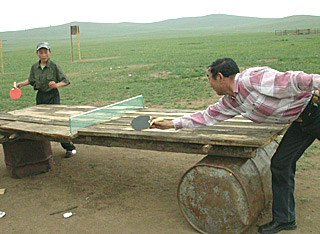 Meat is everywhere—hanging in gers,
stacked on shelves, piled on communal beds. Mongolians living in the steppes
have no refrigerators, and hardly any vegetables either.
Meat is everywhere—hanging in gers,
stacked on shelves, piled on communal beds. Mongolians living in the steppes
have no refrigerators, and hardly any vegetables either.
When Hintzke and I stop for lunch en route to Khentii, on a break from The Blender, the driver tucks into a mutton stew. We pick at something billed as vegetable soup, but which might more accurately be called "meat light"—less gristle and hair than usual.
This paucity of vegetables is curious considering all the arable land in Mongolia, or the productive farms of China’s adjacent Inner Mongolia. A lack of agriculture defines nomadic life, of course, yet fellow nomads in Afghanistan or the African Sahara really have little option but to scratch sustenance from surroundings of considerable hardship.
Mongolians may well be the world’s only people who could farm, but simply prefer not to. Old tales tell of a belief that Earth is Mother, and Mongolians refuse to cut her. Whatever, they really don’t seem comfortable around vegetables, at least not the way they do around meat.
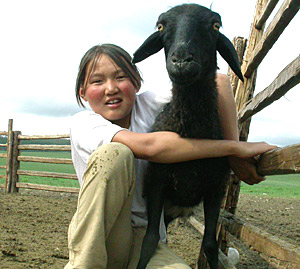 At
our lunch break, I watch as a six-year-old girl is scolded by her mother to help
in the kitchen, disappears inside, then promptly returns, holding a severed
sheep’s head by one ear. She swings it as she strides, like a stuffed toy, and
deposits it neatly in a nearby bin without any sign of distaste.
At
our lunch break, I watch as a six-year-old girl is scolded by her mother to help
in the kitchen, disappears inside, then promptly returns, holding a severed
sheep’s head by one ear. She swings it as she strides, like a stuffed toy, and
deposits it neatly in a nearby bin without any sign of distaste.
Hintzke confides that the hardest part of his restoration project is the meat riots. "Every so often, someone stirs up the local staff with stories about how we are running out of mutton. Then the word goes around that I plan to poison them—meaning, serve them vegetables.
"Honestly! Nothing—not talk or reason—solves the problem until we buy and slaughter a goat. Then they calm down," he says. "Mongolians really need their meat."
The national mania for mutton is one of many problems facing Mongolia’s tour operators. Outside UB, roads are poor or nonexistent. Rail links connect with Russia and China, but border crossings are nightmarish, involving five- to six-hour waits on the China side, where undercarriages must be changed to suit the wider track gauge.
Nor do Mongolians smooth any process. Crossing by land, on my second trip in the summer, reveals that the worst dregs of communist bureaucracy – corruption, payoffs, plain meanness – survive at the furthest outposts of the country, continuing to cripple it. I spend half a day pushing and shoving my way past roadblocks and bribe-hungry guards.
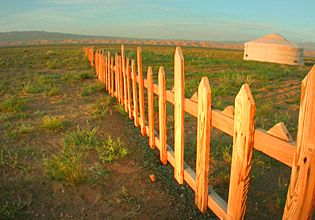 Then there is the matter of accommodation. Hotels in UB are mostly
substandard and overpriced. Beyond the city, there is little besides ger camps
of varying quality, and not really enough of those. Touring the southeast, I
sleep mainly in government offices.
Then there is the matter of accommodation. Hotels in UB are mostly
substandard and overpriced. Beyond the city, there is little besides ger camps
of varying quality, and not really enough of those. Touring the southeast, I
sleep mainly in government offices.
Had the Visit Mongolia campaign been a success, there would have been no place for visitors to stay. Not that there was ever much risk of that.
The only evidence of a tourism campaign I ever see, apart from the web site, are Visit Mongolia 2003 stickers, which, I’m informed, were distributed only within Mongolia.
Back in UB, Enkhbayer Monkhbaatar, the director general of the Mongolian Tourism Board, tells me that his entire promotion budget is only US$100,000.
Monkhbaatar, an old-style bureaucrat, insists that the campaign will be successful in the long run. If not, SARS is to be blamed. Given that most tourists arrive by way of China, this isn’t farfetched; indeed, arrivals were off by at least 50 percent during my visit.
But the worst effect of SARS may have been to provide bureaucrats with a handy excuse for the lack of visitation. "We didn’t give the campaign enough lead time," another official concedes, anonymously. "SARS was a disaster, but we also blew it."
Nobody is much surprised. "Mongolians really have no idea what tourists want," says Kent Madin, an unabashed Mongolia booster. He and his wife, both Americans, were married here, and for the past decade their Boojum Expeditions has taken tourists on rugged horseback rides and fly-in fishing trips to pristine wilderness.
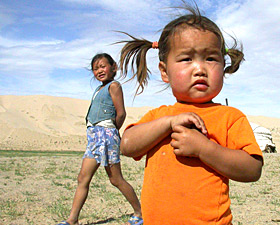 "Tourists come here for the difference. They
really don’t want to be waited on hand and foot." Boojum uses simple
lodges or camps, and avoids ger villages with
ethnic folk shows run by government tourist agencies. "That’s just not
the Mongolia people come here to see," Madin says.
"Tourists come here for the difference. They
really don’t want to be waited on hand and foot." Boojum uses simple
lodges or camps, and avoids ger villages with
ethnic folk shows run by government tourist agencies. "That’s just not
the Mongolia people come here to see," Madin says.
To be fair, Mongolia has come a long way in the decade since Zulchin, a state-run bureau modeled on the Soviet Union’s abominable Intourist, oversaw tourism. In a nation where the average income is less than US$500, tourism now constitutes a crucial asset. It’s also one of the few domestic industries with an upside, growing 10 to 20 percent annually.
And while there are plenty of natural factors working against it—the short tourist season, the high cost of maintaining facilities through the harsh winters, the mutton—the industry is bullish. Mongolian Resorts will soon open an upscale lodge an hour’s drive from UB.
Already running since this past summer is Hotel Mongolia, a ger resort with flush toilets on the fringes of UB. But for real innovation, I’m told to visit Three Camels Lodge in the Gobi Desert.
I didn’t need any convincing. You might say I have been Gobi-bound for over a decade. During a visit in 1992, I was stymied by the post-Naadam transport freeze. As soon as flights resumed I snapped up tickets to the Gobi.
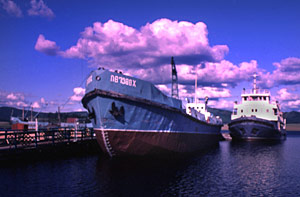 But then I
heard about the Mongolian Navy—three boats, two guns, one engine—and decided
to detour to Lake Khovsgol to have a look. Nowadays the lake is probably the
country’s top tourist destination; back then it was just a long, laborious
drive.
But then I
heard about the Mongolian Navy—three boats, two guns, one engine—and decided
to detour to Lake Khovsgol to have a look. Nowadays the lake is probably the
country’s top tourist destination; back then it was just a long, laborious
drive.
We tallied 13 flat tires, with no jack or spare. The last one punctured my plans to go to the Gobi. I missed my flight and spent the night lying on a hillside, sighing at the stars and singing Beatles songs with my guide Ariunbat, president of UB’s Sgt. Pepper’s Fan Club, membership numbering one.
Eleven years later, by a quirk of fate, I’m put in touch with Ariunbat again, who now runs his own media firm. We dine at the newly opened Modern Nomads, which bills itself as a health restaurant.
Down the block from Mongolia’s only bowling alley, Modern Nomads is a pleasant place run by a women’s collective. The menu—surprise—is all mutton, but traditional recipes are updated with sauces and healthier ingredients: let’s just call it mutton-fusion.
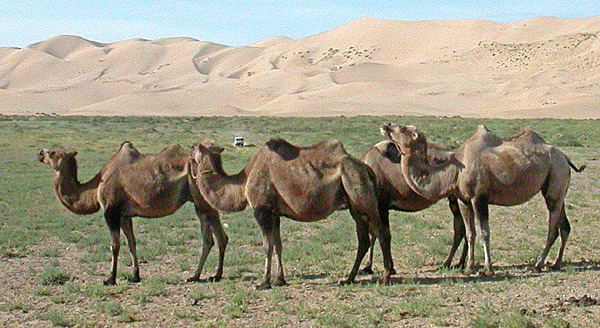 Over a bowl of mutton and noodles, Ariunbat says, "Finally,
you are getting to the Gobi. You know, I think you will really come to
understand Mongolia in the desert."
Over a bowl of mutton and noodles, Ariunbat says, "Finally,
you are getting to the Gobi. You know, I think you will really come to
understand Mongolia in the desert."
Approaching Three Camels Lodge the next day, I think I’m seeing a mirage. After the icy tongue of Yolyn Am, and having watched wild camels romp across the Gobi, anything else would seem bound to disappoint. Not Three Camels Lodge.
Modeled on a ger camp, its sandstone tiles and weathered wood blend into the desert landscape. Nomadic Expeditions, the owners, went first-class all the way. Power comes from solar panels and windmills. Waste disposal is state-of-the-art. Fittings, while far from opulent, are designed for comfort and harmony with the Gobi. I immediately dub it "Amangolia."
"We think of it as an eco-lodge," says Nomadic Expeditions’ vice president, Yondon Badral, who confides that the cost spiraled to US$300,000, about 10 times that of a typical ger camp. Not that much is typical about this place.
For breakfast, there is toast and jam and real cheese. Shower stalls are tidy, with towels and toiletries at the ready. Nothing is particularly extravagant, but all the right touches are in place, like damp washcloths before meals, and impeccable service from smiling staff.
At night, I retire to my ger and to the first decent bed I’ve slept in since my arrival. Reflecting on Ariunbat’s words, I find myself trying to define the exact appeal of Mongolia. Visitors either love the place or hate it, passionately, often for the same reasons: the difficulty, the difference, the radical extremes.
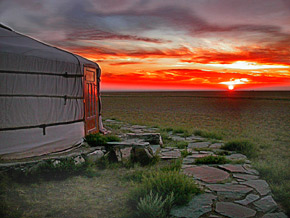 Boosters generally outnumber critics and most visitors rave
about Mongolia. But I cannot help noticing how few of those who call this the
Last Great Place ever make a repeat visit.
Boosters generally outnumber critics and most visitors rave
about Mongolia. But I cannot help noticing how few of those who call this the
Last Great Place ever make a repeat visit.
Regardless, Mongolia claims a special something, and it all seems to shine at Three Camels. Or maybe it’s just the bed. Whatever, my dreams are grand, my days glorious. I’m not only soaking up sunsets, but also rising at dawn every day for glorious sunrises. File that among the Top Ten Reasons to Visit Mongolia.
The awesome, unalloyed light is one attraction. Then there are the evocative rock formations, like those around Senjit Khad, north of Sainshand, and the Flaming Cliffs near Vulture’s Mouth Gorge, famed for their dinosaur fossils. Mostly, though, the sense is exhilaration, of being swallowed up in this stunning vastness.
Maybe it’s the lack of roads, but you get this feeling of intense freedom, as if traversing enormous territory nobody has touched before. Even when you spot a few gers, they seem only temporarily secured, like seeds too restless to take root.
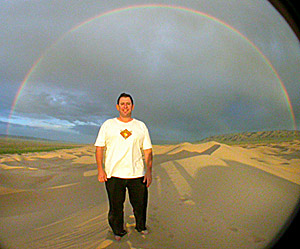 If all this seems rather reflective, blame the long, mesmerizing desert
daydreams. And the magic moments. There are plenty of those, but the best comes
at Khongoryn Els, home to some of Mongolia’s largest dunes, known as the Duutr
Mankhan, or "singing sands."
If all this seems rather reflective, blame the long, mesmerizing desert
daydreams. And the magic moments. There are plenty of those, but the best comes
at Khongoryn Els, home to some of Mongolia’s largest dunes, known as the Duutr
Mankhan, or "singing sands."
This is the highlight of most expeditions to this part of the Gobi. Unfortunately, I arrive in the middle of a rare summer rainstorm. We climb the dunes, both my driver and guide good-naturedly tagging along. It’s a muddy slog, and we nearly turn back several times. The worst is when winds whip up the sand to face-blasting speeds. We dive for cover in the lee of the dunes.
But we wait it out. Just before sunset, the reward streams through the clouds: a huge rainbow, colorful and complete. As the sun falls, a second rainbow appears, creating a pair of vivid arches, dune to dune. Minutes later, the sky is a kaleidoscope of gold, crimson, and orange.
I’m beaming, and so are my companions. These are the moments that make Mongolia worth the wait, the battle, even the mutton. It’s the magic of the Last Great Place.
Ron Gluckman is an American journalist who has been roaming widely around Asia since 1990 for a variety of publications, including Destinasian (www.destinasian.com) a travel magazine that ran this piece in December 2003.
Ready to roll? For tips on travel, where to stay and whom to book with, look at my easy guide.
To return to the opening page and index

push here
[right.htm]